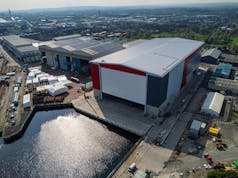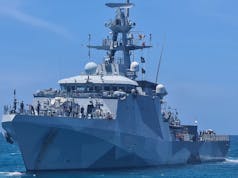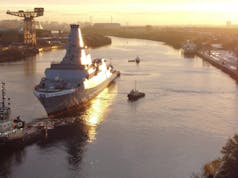Defence Secretary Michael Fallon has announced that work will start on the UK’s new nuclear missile submarine fleet with a £1.3 billion investment.
The Successor project will now move into the next stage, known as ‘Delivery Phase 1’, with manufacturing work beginning on structural steel work for the ‘auxiliary machine space’ of the first submarine: this contains switchboards and control panels for the reactor.
The money will also be spent furthering the design of the submarine, purchasing materials and long lead items, and investing in facilities at the BAE Systems yard in Barrow-in-Furness where the submarines will be built.
Defence Secretary Michael Fallon said:
“Britain’s ballistic missile submarines are the ultimate guarantee of our nation’s safety – we use them every day to deter the most extreme threats.
We cannot know what new dangers we might face in the 2030s, 2040s and 2050s so we are acting now to replace them.
Along with increasing the defence budget to buy new ships, planes and armoured vehicles, this shows that this Government will never gamble with our national security.
The investment will support delivery of the manifesto commitment on which this Government was elected, to retain the Trident-based continuous at sea deterrent – the ultimate guarantee of our safety –and build the new fleet of four Successor Ballistic Missile submarines: securing thousands of highly skilled jobs in the UK.
That commitment was underlined in the 2015 Strategic Defence and Security Review and supported decisively by an overwhelming majority in Parliament on 18 July 2016, sending a strong message to the hundreds of companies involved in the submarine supply chain that they – and their tens of thousands of employees across the country – can keep planning for the future.”
 Tony Johns, Managing Director of BAE Systems Submarines said:
Tony Johns, Managing Director of BAE Systems Submarines said:
“This additional financial investment by the MOD is an expression of confidence in our ability to build these sophisticated vessels.
We have been designing the new class of submarine for more than five years and thanks to the maturity of our design, we’re now in a position to start production on the date we set back in 2011. This is a terrific achievement and I pay tribute to all those who have made this possible.”
The Successor programme already employs more than 2,600 people across MOD and industry, including 1,800 at BAE Systems.
Thousands more will be employed in the supply chain with an average of 7,800 people expected to be working on Successor each year throughout the duration of the programme.
At peak, in the early 2020s, BAE Systems anticipates employing more than 5,000 people on the Successor programme.












The problems associated with letting single-source contracts on strategically important equipment programmes like the new Trident nuclear submarines are not only limited to the usual delays and cost overruns – they extend to the contractual support arrangements put in place to acquire and re-provision Support Assets to sustain the equipment in-service, for the full period of its service life.
If past record is anything to go by, this aspect of defence procurement will only deliver further spiralling costs – and a headache for the Treasury.
What the Treasury should be budgeting for is the whole-life sustainment cost for this weapons platform – given the fact that the cost of acquiring and re-provisioning Support Assets associated with military equipment over the whole life cycle can be in the order of four to five times the prime equipment costs – which, for Trident has now been estimated at £180bn.
Even the most recent Permanent Secretary at the Ministry of Defence admitted to the Public Accounts Committee that, it is the likelihood of financial risks on the Trident replacement programme materialising soon after contract award, which keeps him awake at night.
Anyone who has worked in the defence engineering industry will know that financial risks start-out as innocuous looking technical risks on the Defence Contractor’s premises, where selected ones are deliberately concealed by the Contractor during the design and development phase, then skilfully transferred to MoD Abbey Wood, Bristol where they morph into ‘show stopping’ risks and come to the fore immediately after the main investment decision has been taken (as they have done so spectacularly on the Type 45 destroyers with total power blackouts), ultimately ending up as an additional cost burden on the Front Line Commands, who have recently been given responsibility for the defence equipment budget – resulting in sleepless nights for many other people too!
This happens because a key behavioural characteristic of Defence Contractors is that they will always choose to conceal technical risks identified early in the programme, by engaging with procurement officials and getting them to focus on declared risks which ordinarily fall in the trivia category, whilst skilfully diverting their attention away from those really huge ‘show stopping’ risks which they will only reveal later on, when things go wrong, to realise their objective of ‘growing’ the Contract by getting Abbey Wood Team Leader to raise Contract Amendments and/or let Post Design Services Contracts.
They achieve this by contriving situations which entice procurement officials into partaking in detailed design decisions relating to the evolving Technical Solution, and then use this involvement to coerce procurement officials into raising Contract Amendments later on. Indeed, it the very existence of Contract Amendments and PDS Contracts that causes Contractors to conceal ‘show stopping’ risks in the first place!
These concealed risks then come to the fore immediately after (never before) the main investment decision has been taken, surprising everyone (except the Contractor) and imposing a budget-busting burden on MoD.
And because there exists no ‘Code on Ethical Behaviour in Business’ which would offer protection to good people on the Contractor’s payroll (generally in the direct labour category) who are driven by strong professional, ethical and moral values and who would otherwise blow the whistle on this conspiracy of concealment, they are forced to remain silent.
The only people who are not in the know about this blatant scam are those in the pay of the State!
So the chances of financial risks coming to the fore on the Trident renewal programme soon after contract award are about as certain as night follows day.
@JagPatel3 on twitter
Yet again the contract gone to BAE Systems the could’nt build the Astute class “The PWR2 was shoehorned into the Astute, and it meant the submarine’s initial designs had to be changed,”That is why the Astute has a slightly bulbous look about it, not the clean lines that you might expect. The reactor was never meant for an attack submarine and it is supplying power to machinery whose designs have not greatly changed for 50 years. In very simple terms, it is like hooking up a V8 engine to a Morris Minor gearbox.””Even though they know some things are wrong, they keep on building them. This is the boat the MoD deserved. They messed around with the procurement. They kept changing the specifications. They kept delaying the project. If this had been the US navy, they would have scrapped the boat. They would have recognised the flaws and decided not to take any risks.”
And still the goverment give £1.3 billion to BAE to build another crap Submarine for the Uk Navy
ffs who are you ”’ you know more than the navy ”’behave and leave it to the ppl who know you crank
Not to point out the obvious, or anything, but PWR2 was *designed* for missile submarines. Your opinion about its suitability for Astute has nothing relevant to say about its suitability for the successor submarine.